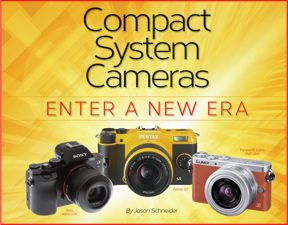
Whether you call them compact system cameras (CSCs), mirrorless interchangeable-lens cameras (MILCs) or ILCs, this rapidly evolving class is having an increasing impact on the middle and upper strata of the U.S. camera market. And it is beginning to seriously challenge the once unassailable supremacy of the mighty DSLR.
Until recently, the conventional wisdom was that CSCs were the hot ticket in Asian and, to some extent, European markets, but their appeal among American photo enthusiasts was lackluster. Based on my admittedly unscientific “survey” of half a dozen retailers across the country, this is no longer the case. The general consensus was that DSLR sales (other than high-end pro models) are flat or declining slightly, whereas CSC sales are on the upswing. This is especially true among higher end, full-featured, enthusiast-aimed CSCs.
One Midwest photo specialty dealer did report that CSC sales were “dead in the water,” but he also noted he doesn’t actively promote them and that the CSCs he offers are lower end models lacking EVFs. The majority that reported increasing CSC sales estimated they constitute 15–20% of their camera sales in any given month—quite a different story.
This ought to tell you something, namely that CSCs with the greatest upside market potential are those that provide full DSLR functionality. Consumers recognize that CSCs generally have larger sensors than point-and-shoot cameras and deliver higher image quality than their smartphones. But they’re also looking for first-class viewing in any light and the optical flexibility of interchangeable lenses. The fact that some of the latest high-tech CSCs offer full-time, on-sensor, phase-detection autofocus and hybrid AF systems, Full HD video capture and built-in Wi-Fi connectivity is also not lost on customers who are increasingly shooting movies and sharing video clips with their families and friends.
While DSLRs remain an important and viable market niche and will continue to be in the foreseeable future, the CSC is no longer a brash upstart that appeals mostly to early adopters and techno-geeks. It is beginning to emerge as a leading camera category for everyone from casual shooters to enthusiasts, and even a few pros.
The technological future of photography may lie, as many experts predicted, beyond the DSLR mirror box and in a brave, new world of compact system cameras that leverage the potential of full-time autofocus, virtually limitless framing rates and enhanced responsiveness.
A Baker’s Dozen of CSC Contenders
Samsung Smart NX mini. Sporting a hypermodern design and a 20.5 megapixel, 1-inch, backside-illuminated CMOS sensor (with a 2.7x crop factor), this svelte NX-M mount CSC provides an impressive feature set. It includes a 3.0-inch, 460.8k-dot, touch-screen LCD that tilts 180º; Full HD 1080p video capture at 30 frames per sec; built-in Wi-Fi connectivity with NFC and a host of sharing features; and full-res, 6-fps RAW continuous shooting. It provides ISO 100–25,600 settings, 35-point contrast-detection AF, a 1/16,000-sec shutter speed, smart filters, wink shot mode, which takes a photo when it detects a wink, and microSD card support. The mini comes in four colors and is bundled with Adobe Lightroom 5 and an SEF-7A flash. $549.99 with NX-M 9–27mm f/3.5–5.6 lens. samsung.com
Samsung Smart NX30. The flagship of Samsung’s APS-C-format NX mirrorless cameras with DSLR functionality, the NX30 is configured like a DSLR—complete with a built-in, tilting, 2,359k-dot eye-level viewfinder that makes low-angle shooting easier. Targeted at enthusiasts seeking high imaging performance, it features: a 20.3MP CMOS sensor; a 3.0-inch AMOLED swivel touch display; Full HD 1080p stereo video capture; 3D panorama capability; ISO 100–25,600; and instant sharing via built-in Wi-Fi with NFC. Its maximum burst rate is an impressive 9 fps and it includes a hybrid AF system, Samsung’s i-Function mode and several creative functions. $999.99 with 18–55mm f/3.5–5.6 lens and Photoshop Lightroom 5. samsung.com
Pentax Q7. The most recent iteration of the engagingly ultracompact Q series, the Q7 employs a backlit, 1/1.7-inch CMOS sensor with a 4.6x crop factor. It offers a host of enthusiast-aimed features, including: ISO 12,800; 12-bit RAW + JPEG capture; a 1/2,000-sec shutter speed; 5-fps full-res bursts; in-camera sensor-shift shake reduction; full manual controls; 19 smart effects and creative modes; bokeh control; and a dedicated hot shoe for an external flash or viewfinder. It records Full HD video at 24 and 30 fps and shoehorns a 3.0-inch, 460k-dot LCD into its petite body. It works with seven dedicated specialty lenses and supports wireless Eyefi memory cards. The Q7 can be ordered in 120 color combinations! $499 with 5–15mm f/2.8–4.5 lens. us.ricoh-imaging.com
Fujifilm X-T1. This new top-of-the-line model features a classic DSLR-like form factor and a weather-sealed body. It uses the same 16.3MP APS-C-format X-Trans CMOS II sensor with a unique color pixel array for reduced noise and increased resolution as the rangefinder-style X-E2—along with many of its functions and the upgraded EXR II processor. Its features include: hybrid AF; a 2,360k-dot OLED eye-level viewfinder; a 3.0-inch, 1,040k-dot LCD; Full HD 1080p video capture at 60 fps with stereo sound; and creative features like film simulation. Upgrades include full-res, 8-fps continuous shooting, a shoe-mount flash unit and ISO settings that top out at 51,200. Its electronic/mechanical shutter provides speeds from 30–1/4,000 sec, and it offers built-in Wi-Fi for image sharing and remote control via smartphones. $1,699.95 with XF18–55mm f/2.8–4 lens. fujifilmusa.com
Fujifilm X-E2. Aimed at serious enthusiasts, this CSC provides full DSLR functionality but looks and handles like a classic rangefinder 35, complete with analog dials. It delivers on its high-tech image with a 16.3MP APS-C-format X-Trans CMOS II sensor with a unique color pixel array said to reduce noise and increase resolution, and an upgraded EXR II processor. It also features: hybrid AF; a 2,360k-dot OLED eye-level viewfinder; a 3.0-inch 1,040k-dot LCD monitor; Full HD video capture at 60 fps; a 7-fps burst rate; a focal-plane shutter; ISO 25,600; creative features; digital split image and focus-peaking manual focus; and built-in Wi-Fi. Its magnesium alloy body incorporates a unique X-mount (with a 10-pin data bus) that’s only 2.5mm thick, contributing to the camera’s slim profile. $1,399.95 with XF18–55mm f/2.8–4 lens. fujifilmusa.com
Olympus OM-D E-M1. The flagship of Olympus’s Micro Four Thirds line, the E-M1 delivers the full DSLR experience in a light, compact body with an array of performance and convenient features. These include: a 16MP Live MOS sensor; an integrated, interactive EVF that displays a 2,360k-dot image at 1.48x with instant auto switching to a 3.0-inch, 1,037k-dot, tilting touch-screen OLED monitor; a FAST AF system with 81 contrast-detection zones, 37 phase-detection zones and four AF area sizes; a lag time of just 0.044 sec; a 5-axis sensor-shift IS system; 10-fps bursts; and Full HD video capture. Its ingenious camera control array is optimized for fast, intuitive operation and includes eight customizable control buttons and a two-dial-plus-function-lever system that simplifies adjustments on the fly. Other features: wireless connectivity; 12 art filters; color creator; interval shooting; time-lapse video; ISO 25,600; and a weatherproof magnesium alloy body. $1,299 body only. olympusamerica.com
Olympus OM-D E-M10. This broad-spectrum CSC provides many key features of the flagship MFT OM-D E-M1 in an elegantly compact package. It employs a 16.1MP Live MOS sensor that, along with a state-of-the-art TruePic processor, delivers crisp, high-res images and Full HD 1080p video at 30 fps. It also features: an 81-point FAST AF system; 8-fps full-res bursts; a 1,440k-dot EVF with an impressive 120-fps refresh rate; a 3.0-inch, 1,037k-dot, tilting touch-screen LCD; in-body 3-axis image stabilization; creative modes; and built-in Wi-Fi for sharing and remote shooting via smartphones/tablets. $799.99 with M.Zuiko 14–42mm f/3.5–5.6 lens. olympusamerica.com
Panasonic Lumix DMC-GM1. Panasonic’s elegant, rangefinder-style MFT entry has a 16MP Live MOS sensor and an advanced Venus engine to deliver high-res images and low-light sensitivity to ISO 25,600. It supports Full HD video recording at 60 and 24 fps in the AVCHD format, and delivers a full-res, 5-fps burst. Other features include: Light Speed AF that functions at 240 fps for enhanced responsiveness; a 3.0-inch, 1,036k-dot, touch-screen monitor; built-in Wi-Fi; auto HDR mode; an assortment of creative still and video functions; and a pop-up flash. This is all built into a stylish 3.9×2.2×1.2-inch body with a magnesium alloy chassis and an aluminum alloy top dial, shutter release and leatherette wrap. $749.99 with Lumix G Vario 12–32mm f/3.5–5.6 lens. panasonic.com
Panasonic Lumix DMC-GX7. With the look of a classic rangefinder, this mirrorless MFT-system camera offers the complete DSLR shooting experience. Called a creative street camera, it features a 16MP Live MOS sensor, ISOs to 25,600 and excellent responsiveness. Its 3.0-inch, 1,040k-dot, tilting touch-screen LCD monitor and a 90º tilting, 2,765k-dot EVF provide convenient navigation and excellent viewing options. The camera records Full HD video at 60 and 24 fps and features: 5-fps shooting; built-in Wi-Fi/NFC; a silent shutter mode; stop-motion animation; auto HDR and multi-exposure modes; a level gauge; easy image retouching; and creative panorama mode. It is solid, well balanced and has an ergonomic, built-in grip. $949.99 with 14–42mm f/3.5–5.6 lens. panasonic.com
Sony Alpha α6000. A milestone in the evolution of the CSC, the α6000 takes the performance parameters of the breed up a few notches with 179 on-sensor, phase-detection AF points that cover 90% of the image area; a 3.0-inch, 9,216k-dot, tilting LCD; and a 0.39-inch, 1,440k-dot OLED EVF. Other key features include a hybrid AF system capable of achieving precise focus for stills and video in 0.06 sec and full-time AF when shooting video; an APS-C-format 24.3MP HD Exmor CMOS sensor; the high-tech Bionz X processor that enhances speed, provides ISO settings to 25,600 and full-res, 11-fps bursts; and Full HD video recording at 60 fps or cinematic 24 fps in MP4, MPEG-4 and AVC/H.264 formats. $799.99 with 16–50mm f/3.5–5.6 lens. sony.com
Sony Alpha α7R. The formidable flagship of Sony’s Alpha E-mount mirrorless cameras, it is a technological tour de force. It boasts a class-leading, full-frame 36.4MP Exmor sensor coupled to Sony’s Bionz X processor and provides compatibility with A-mount and E-mount lenses (the latter with an APS-C crop factor). The optical low-pass filter was eliminated to provide superior resolution and crisp image detail, and the sensor employs a gapless on-chip lens design to deliver superior image quality. Other features include: ISO settings to 25,600; a 3.0-inch, 9,216k-dot LCD; an XGA OLED EVF; Full HD video recording at 24p/60i/60p with uncompressed HDMI output; built-in Wi-Fi/NFC connectivity; and a multi-interface shoe for attaching accessories from flash units and microphones to lights and monitors. $2,299.99 body only. sony.com
Nikon 1 AW1. The only CSC that’s submersible (to 49 feet), freezeproof (14ºF) and shockproof (a drop of 6.6 feet) without a special housing, this audacious addition to Nikon’s CX-format models has all the 1-series bells and whistles. It offers excellent responsiveness, 14.2MP and 15-fps bursts with AF tracking or a blistering 60 fps with focus locked. Distinctive features include built-in GPS, an electronic compass, a depth gauge, a virtual horizon display and location data functions. Its outdoor display function makes shooting data easier to read in sunlight, while an action control feature makes navigating menus easy with a tilt of a gloved hand. There are three underwater options—standard, scuba and close-up—as well as underwater white balance and distortion control. To transfer wirelessly, users must buy the optional WU-1b wireless mobile adapter. $799.95 with AW 11–27.5mm f/3.5–5.6 lens. nikonusa.com
Nikon 1 V3. The latest enthusiast-aimed flagship of the Nikon 1 line, it sports a higher res, 18.4MP CX CMOS sensor and an advanced Expeed 4A processor to deliver an impressive 20-fps burst rate with full-time AF. And it uses a hybrid AF system that combines on-sensor phase-detection and contrast-detection sensors. Other features include: a 3.0-inch, 1,037k-dot, tilting touch-screen LCD; Full HD video capture at 60 fps; built-in Wi-Fi that supports WPS; ISO 160–12,800; and movie e-VR image stabilization for smooth videos. The V3 comes with a shoe-mount 2,359k-dot, eye-level EVF and an accessory grip. $1,199.95 with Nikkor VR 10–30mm f/3.5–5.6 lens. nikonusa.com





